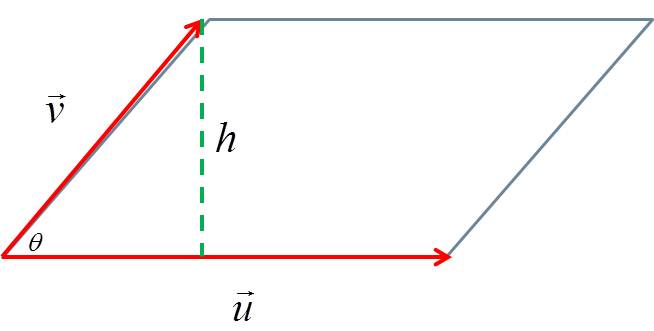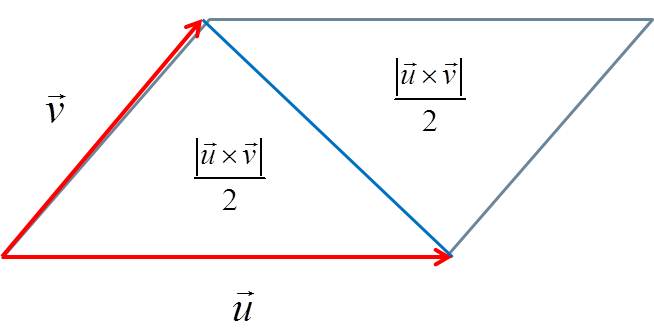Cross Product
Definition
The cross product of two vectors is defined as follows
(1)where the vector $\hat{n}$ is a vector of unit length that is perpendicular to both the vector $\vec{u}$ and $\vec{v}$. The direction of the vector is determined by the right-hand rule. Point your fingers in the direction of $\vec{u}$ and curl them in the direction of $\vec{v}$ and your thumb will point in the direction of $\hat{n}$

Because of the right-hand rule, if you switch the order of the vectors, $\hat{n}$ switches to the opposite direction. Therefore, $\vec{u} \times \vec{v}=-(\vec{u} \times \vec{v})$
Since $\hat{n}$ is a unit vector, $\vec{u} \times \vec{v}$ is written as the product of its magnitude and direction. Where the direction of $\vec{u} \times \vec{v}$ is $\hat{n}$ and $|\vec{u} \times \vec{v}|=|\vec{u}||\vec{v}|\sin \theta$
Example
Find the magnitude of the cross product of $\vec{u}=15@45^\circ$ and $\vec{v}=4@100^\circ$
Notice that if $\vec{u}$ and $\vec{v}$ are parallel then,
(2)or
(3)Calculating the Cross Product
For the purposes of calculation, this definition is not usually useful. It does not explicitly tell us how to find the vector $\hat{n}$. Instead, if we are given two vectors in component form
(4)then
(5)Unlike other operations the cross product is not commutative. That is to say $\vec{u}\times\vec{v}\neq\vec{v}\times \vec{u}$.
(6)Finding the Equation of a Plane
We describe a plane by a point on the plane, $P(x_0,y_0,z_0)$, and a vector perpendicular to the plane called a normal vector, $\vec{N}=<A,B,C>$. Looking at the image below, notice that any vector that we create in the plane will be perpendicular to $\vec{N}$. So the vector $\vec{PQ}=<x-x_0,y-y_0,z-z_0>$ is perpendicular to $\vec{N}=<A,B,C>$. We know, that for perpendicular vectors, the dot product is zero. Therefore we have,
(7)The standard equation of a plane containing a point $P(x_0,y_0,z_0)$ that has a normal of $\vec{N}=<A,B,C>$ is therefore,
(8)
In two dimensions, we know that two unique points will define a line. In three dimensions, the analog is that three non-collinear points, not on a common line, will define a plane. Given those three points, we can construct two nonparallel vectors that lie in the plane. If we take the cross product of those two vectors, we will get a vector perpendicular to the plane. We can use that cross product as the $\vec{N}$ for our plane.
Example
Find the equation of the plane containing the points $P(5,1,1)$ , $Q(0,2,2)$ , and $R(6,2,0)$
Finding the Area of a Parallelogram
We know from geometry that the area of a parallelogram is given by $A=bh$. In the image below we see that the area of the parallelogram would be,

But from right triangle trigonometry we have that,
(10)Combining the facts from 9 and 10, we have that
(11)So the area of the parallelogram whose nonparallel sides are the vectors $\vec{u}$ and $\vec{v}$ can be calculated by the formula
(12)Example
Find the area of the parallelogram with vertices $P(1,1)$ , $Q(5,1)$ , $R(3,3)$ and $S(7,3)$
Finding the Area of a Triangle
Since a triangle can be thought of as half of a parallelogram, the area of the triangle with two sides defined by $\vec{u}$ and $\vec{v}$ can be calculated by the formula
(13)
Example
Find the area of the triangle with vertices $P(1,1,1)$ , $Q(2,1,0)$ and $R(-1,4,2)$
Exercises
- Find the magnitude of the cross product of $11@15^\circ$ and $99@-15^\circ$
- Find the cross product of $\vec{u}=<1,-1,2>$ and $\vec{v}=<0,2,-1>$.
- The points (1,1,3), (2, -3, 3), and (-1, 0, 4) determine a plane. Find the equation of the plane in both standard and dot product form.
- Use cross product to show that $\vec{u}=<1,4,-5>$ and $\vec{v}=<-3,-12,15>$ are parallel.
- Find the area of the parallelogram with vertices (0,0) , (3,7) , (2,5) and (5,12)
- Find the area of the parallelogram with vertices (0,0,0) , (3,2,4) , (5,1,4) and (2,-1,0)
- Explain, in terms of the definition, why $\vec{u} \times \vec{v} = -(\vec{v} \times \vec{u})$
- Find the area of the triangle with vertices (1,2,-1) , (4,1,0) and (3,8,1)
- Find the area of the triangle with vertices (1,-1,2) , (2,0,-1) and (0,2,1)
- Find a vector perpendicular to the plane $5x-3y+6z=8$
- If the vectors $\vec{u}$ and $\vec{v}$ are 3D vectors parallel to the xy-plane, what do we know about their cross-product?